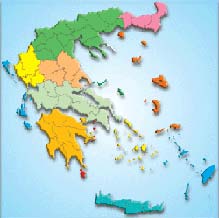
Please click on the map,
the region you want to visit |
|
|
|
|
| |
|
 |
Sights of Rhodes of Rhodes |
|
| NATURAL HISTORY MUSEUM OF BUTTERFLIES |
In the region of the Valley of Butterflies and after the initiative of Municipality of Butterflies, was founded and operates the Natural History Museum of Rhodes.
Italian buildings of 1930, specifically designed house the museum, giving to visitors the opportunity to combine the walk through the beautiful valley with the right scientific briefing on subjects that concern the flora and fauna of this unique habitat.
In special showcases, that are manufactured with museumological perceptions and in conditions of a natural environment, the splendid exhibits of Museum are presented.
In the total of exhibits are included endemic and infrequent species that live in the wider region of the valley at the island of Rhodes but also and in remainder Greece, as well as minerals and rocks.
Special interest presents the hatchery - showroom of butterflies, with live exhibits, which are bred and kept in a suitable greenhouse, which is manufactured at the Museum.
Still, in the space of the Museum, through the special room of control and the closed circuit that functions 24 hours a day, the area of valley is checked, so that the ecological balance of the habitat to be protected from the visitors.
Moreover, in the area of Museum there is a library and a appreciable Entomology and Botanical laboratory. The Museum of Natural History with its operation, the activities and generally its offer, contributes in the ecological upgrade and growth of the region, constituting the core of environmental education, briefing, scientific research and the study of the local ecosystems. It contributes in the management and protection of the particular natural beauty of habitat of the Valley of Butterflies. |
| THE BUTTERFLY VALLEY - Virgin Mary KALOPETRA |
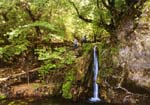 One of the most popular and interesting attractions of Rhodes is the famous Valley of Butterflies with its unique flora and fauna. One of the most popular and interesting attractions of Rhodes is the famous Valley of Butterflies with its unique flora and fauna.
It has a length of 6 km with streams, pine trees, colorful flowers and, of course, thousands of butterflies.
It is 16 km south-western of Rhodes Town.
During the summer season, the area is inundated with butterflies and it is an attraction for thousands of excursionists of Rhodes. Many people and many researchers - scientists are visiting the valley, in order to enjoy the spectacle and observe the rare phenomenon.
You will see thousands of butterflies on tree trunks seeking for food and dew.
More common is the butterfly of Rhodes with the scientific name "Butterfly the Tetragonostiktos" or with the Latin name "Panaxia Quandripunctaria".
The valley is beautifully landscaped with artificial lakes, little bridges and streets to facilitate the walking of visitors.
At the top of the valley is found the Monastery that is dedicated to Virgin Mary Kalopetra, which holds an important place in the newer history of Rhodes.
The Church is on a small plateau of the mountain "Lefkopoda" or "Leftopagos" and it has been built by Alexander Ypsilantis, after a miracle, as the delivery says.
The monastery was a cenobitic monastery and it was in great prosperity until the beginning of this century, with a great contribution to education.
It had cells that had served as dormitories for the monks, reading rooms and stores. |
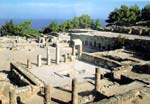
The area of Kamiros extends to the north-western beach of the island near the cape of Agios
Minas.
Findings from the Geometric period indicate the existence of a temple dedicated to Athena at the citadel. The earthquake in 226 BC destroyed the classical city and possibly the classical temple of Athena Kamiradas.
The Hellenistic city has been built according to Ippodamio system at three levels. At the top of the hill is the citadel with the temple of Athena and the Gallery. In the middle is the main settlement and lower is the Hellenistic temple, the Doric fountain, the market and the altar wall. The earthquake in 142 BC destroyed the city for a second time.
Excavations at the citadel were first introduced by Biliotti and Salzmann in 1852-1864.
The archaeological site of Kamiros includes the village, which is configured in three levels on the hill with the following monuments: |
* Citadel with the temple of Athena Kamirados. The Temple, Doric, four-columned, booth (galleries with columns in the four outer sides) that defined by a precinct.
* The Tank. A rectangular construction invested with mortar. It had a capacity of 600 cubic meters of water, a sufficient storage for 300-400 families. It is dated back the 6th-5th century BC.
* Hellenistic portico. It was consisted of two lines of Doric columns and shops or dwellings for the pilgrims at the back. There is a remarkable water supply system with wells under the floor, underground tanks and water clay pipes, which replaced the older tank.
* The four side altar of Hellenistic period, preserved in front of the Doric portico.
* The Small village of Hellenistic and Roman period, built according to the Ippodamio system (ie, vertical and parallel streets formed residential blocks of a particular size, so-called islands-insulae-), is extended in the intermediate level of the hill.
* The Hellenistic temple in the third - the lowest level of the archaeological site. Limestone temple, with two columns, with vestibule, nave and a back entrance. The temple was probably dedicated to Pythian Apollo.
* The Ionic temple, lined with limestone mortar that was used to house a votive statue.
* The fountain. The facade consists of Doric, limestone columns lined with plaster, which supported the entablature.
* The four sided Square (market) lies in front of the fountain for the gathering of civilians during the religious ceremonies, with three levels in the southern and eastern side. Later, walls closed the northern and the southern side and doors were constructed as a passage for the pilgrims. Small columns adorned the northern wall, while, at the south-eastern corner, there is still a four-sided construction, perhaps for the offerings.
* The yard with the altars. On the north-eastern side of the third level along the retaining wall have been installed inscribed altars - in two levels - dedicated to various deities (Kind Daemon, Artemis, Zeus, Poseidon, etc.). At the first level is preserved a large oblong altar dedicated to Sun.
There was a semi-circle podium in front of the yard of the altars with a platform for offerings. A large stair between the market and the perimeter of the altar leads to the residential center. |
| EPTA PIGES (SEVEN SOURCES) |
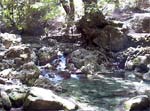 A small paradise in the middle of the island with the greenfull nature, the perennial trees and the abundant running waters that create a shelter of coolness and relaxation for sightseers on the island of Rhodes. A small paradise in the middle of the island with the greenfull nature, the perennial trees and the abundant running waters that create a shelter of coolness and relaxation for sightseers on the island of Rhodes.
The area got its name from the natural springs that gush from seven points.
The water, via a tunnel, ends in a small lake (200 m. approximately in length and a width ranging from 10 to 50 meters. The depth is from 1 to 8 meters.), which is formed with the help of a dam. The Lake of Seven Sources is the only place in Rhodes, where someone can swim in fresh water and enjoy the dew of running water and of the forest that surrounds the lake.
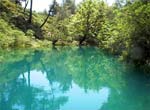
These waters are the home of the rare fish species "Gizani" (which exists only in streams of Rhodes), and in the wider region there are peacocks, ducks, geese, turtles, eels and crabs.
The tunnel has a length of 150 meters and in its middle there is a well that is used as a skylight and as an airway, and the depth is 13 meters. Passing through the tunnel and walking through the water you will feel like you are in another dimension. This experience remains forever etched in the minds of visitors. |
|
|